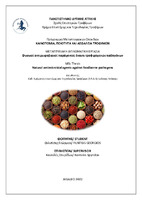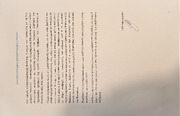| dc.contributor.advisor | Κοντελές, Σπυρίδων | |
| dc.contributor.author | Φιλντίσης, Γεώργιος | |
| dc.date.accessioned | 2022-09-05T10:49:13Z | |
| dc.date.issued | 2022-07-15 | |
| dc.identifier.uri | https://polynoe.lib.uniwa.gr/xmlui/handle/11400/2832 | |
| dc.identifier.uri | http://dx.doi.org/10.26265/polynoe-2672 | |
| dc.description.abstract | Εμπορικά διαθέσιμες σκόνες Μαύρου πιπεριού, Πράσινου πιπεριού καθώς και κόκκινης πιπεριάς Καγιέν προστέθηκαν σε ποσοστό 5% κ.β. σε νερό. Κατόπιν ρυθμίστηκε το pH με 1 N HCl/ 1 N NaOH σε τιμές 4.5, 5.5 και 6.5 και κατόπιν κάθε ένα από τα εναιωρήματα των μπαχαρικών εκτέθηκαν για 5, 30 και 60 min σε θερμοκρασίες 60, 80 και 100οC. Μετά την ολοκλήρωση των επεξεργασιών, τα υδατικά εκχυλίσματα φυγοκεντρήθηκαν και το pH του υπερκείμενου υγρού ρυθμίστηκε στο 7.0. Ακολούθησε αποστειρωτική διήθηση (0.22 μm) και προέκυψε το «μητρικό εκχύλισμα - ΜΕ». Από το ΜΕ σχηματίστηκαν διαλύματα 5.0, 3.1, και 1.2% o.o τα οποία αξιολογήθηκαν ως προς την επίδρασή τους επί τριών Gran θε-τικών βακτηρίων: S. aureus, L. monocytogenes και B. cereus, αρχικού πληθυσμού (εμβόλιο) 104 cfu/mL. Η αξιολόγηση των εκχυλισμάτων έγινε μέσω φωτομετρικής παρακολούθησης της καμπύλης ανάπτυξής τους στο πολυφωτόμετρο/ επωαστήρα (Bioscreen C) σε υγρό θρεπτικό υπόστρωμα BHI και θερμοκρασία επώασης 37οC/ 48 h. Η επίδραση των εκχυλι-σμάτων επί των μικροοργανισμών-στόχων ποσοτικοποιούνταν χρησιμοποιώντας το χρόνο προσαρμογής (lag phase) της καμπύλης ανάπτυξής τους ως δείκτη όπως αυτός προέκυπτε μέσω της εξίσωσής όπως προσαρμοζόταν μέσω του μοντέλου Baranyi & Roberts. Τα απο-τελέσματα ήταν τα ακόλουθα: Τα αποτελέσματα εξαρτώνταν πρωτίστως από το συνδυα-σμό βακτηρίου-εκχυλίσματος. Σε ότι αφορά το S. aureus το 9.87% του συνόλου των εκχυ-λισμάτων μαύρου πιπεριού προκάλεσαν αύξηση του χρόνου προσαρμογής από -20% έως -39% ενώ κανένα δεν περιόρισε πλήρως την ανάπτυξή του. Αντίθετα, το 13.6% από τα εκ-χυλίσματα του πράσινου πιπεριού προκάλεσαν πλήρη αναστολή του μικροοργανισμού-στόχου. Σε ότι αφορά τα εκχυλίσματα πιπεριάς Καγιέν το 2.46% των δειγμάτων προκάλε-σαν πλήρη αναστολή του S. aureus και 2.46% αναστολή από -48.01% έως -53.29%. Αναφο-ρικά με το στέλεχος L. monocytogenes το 13.6% των εκχυλισμάτων μαύρου πιπεριού προ-κάλεσαν αύξηση του χρόνου προσαρμογής από -10% έως -39% ενώ αντίθετα το 24.7% προκάλεσε μείωση του χρόνου προσαρμογής από 10% έως και 39%, δηλαδή ευνοήθηκε η ανάπτυξη του L. monocytogenes. Το 11.1% των εκχυλισμάτων πράσινου πιπεριού προκά-λεσαν πλήρη αναστολή του L. monocytogenes ενώ αντίθετα το 37.0% μείωσε τον χρόνο προσαρμογής από 10% έως 55%, δηλαδή ευνοήθηκε η ανάπτυξη του βακτηρίου. Σε ότι αφορά τα εκχυλίσματα πιπεριάς Καγιέν το 18% αυτών αύξησαν το χρόνο προσαρμογής από -10% έως -39%. Ωστόσο κανένα δείγμα δεν ανέστειλε την ανάπτυξη του βακτηρίου. Σε ότι αφορά το στέλεχος B. cereus, το 27.16% των δειγμάτων μαύρου πιπεριού
X
προκάλεσαν αύξηση του χρόνου προσαρμογής από 10% έως 39% ενώ κανένα δεν πέτυχε πλήρη αναστολή. Από το σύνολο των εκχυλισμάτων πράσινου πιπεριού το 33% αύξησε το χρόνο προσαρμογής από 20% έως 59% αν και κανένα δεν προκάλεσε πλήρη αναστολή (100%). Από τα εκχυλίσματα κόκκινης πιπεριάς Καγιέν ένα δείγμα ανέστειλε την ανάπτυξη του B. cereus, το 11.1% των δειγμάτων αύξησε το χρόνο προσαρμογής από 20% έως 39% και το 5% από 40% έως 59%. Τέλος, θα πρέπει να σημειωθεί ότι από το σύνολο των δειγ-μάτων που αύξησαν το χρόνο προσαρμογής των βακτηρίων-στόχων τα περισσότερα είχαν προέλθει από εκχυλίσεις σε όξινο περιβάλλον (pH 4.5). | el |
| dc.format.extent | 127 | el |
| dc.language.iso | el | el |
| dc.publisher | Πανεπιστήμιο Δυτικής Αττικής | el |
| dc.rights | Αναφορά Δημιουργού - Μη Εμπορική Χρήση - Παρόμοια Διανομή 4.0 Διεθνές | * |
| dc.rights | Αναφορά Δημιουργού 4.0 Διεθνές | * |
| dc.rights | Αναφορά Δημιουργού - Μη Εμπορική Χρήση - Παρόμοια Διανομή 4.0 Διεθνές | * |
| dc.rights.uri | http://creativecommons.org/licenses/by-nc-sa/4.0/ | * |
| dc.subject | Φυσικά αντιμικροβιακά | el |
| dc.subject | Mπαχαρικά | el |
| dc.subject | Staphylococcus aureus | el |
| dc.subject | Listeria monocytogenes | el |
| dc.subject | Bacillus cereus | el |
| dc.subject | Πιπέρι καγιέν | el |
| dc.subject | Πράσινο πιπέρι | el |
| dc.title | Φυσικοί αντιμικροβιακοί παράγοντες έναντι τροφιμογενών παθογόνων | el |
| dc.title.alternative | Natural antimicrobial agents against foodborne pathogens | el |
| dc.type | Μεταπτυχιακή διπλωματική εργασία | el |
| dc.contributor.committee | Zoumpoulakis, Panagiotis | |
| dc.contributor.committee | Batrinou, Anthimia | |
| dc.contributor.faculty | Σχολή Επιστημών Τροφίμων | el |
| dc.contributor.department | Τμήμα Επιστήμης και Τεχνολογίας Τροφίμων | el |
| dc.contributor.master | Καινοτομία, Ποιότητα και Ασφάλεια Τροφίμων | el |
| dc.description.abstracttranslated | Commercially available powders of black pepper, green pepper and red Cayenne pepper added at 5% w/w in water. Then the pH adjusted with 1 N HCl/ 1 N NaOH to 4.5, 5.5 and 6.5 and then each of the spice suspensions exposed for 5, 30 and 60 min at 60, 80 and 100°C. Following heat treatment, the aqueous extracts centrifuged, the pH of the superna-tant adjusted to 7.0, and sterilized by micro-filtration (0.22 μm) and the " Mother-Extract - ME" obtained. From the ME, solutions of 5.0, 3.1, and 1.2% v/v in BHI broth were prepared which, then evaluated for their effect on the growth of three Gran positive bacteria: S. au-reus, L. monocytogenes and B. cereus, with initial population (inoculum) 104 cfu /mL. The evaluation of the different extracts on the growth of the target-strains was carried-out pho-tometrically in the multiphotometer/incubator Bioscreen C in BHI broth medium following incubation for 48 h at 37oC. The effect of the extracts on the target microorganisms quan-tified using the lag time of their growth curve as index as derived through the equation the Baranyi & Roberts model. The results were as follows: The results depended primarily on the bacteria-extract combination. As far as S. aureus is concerned, the 9.87% of the black pepper extracts evaluated, they increased the lag time from 20% to 39% while none of the samples inhibited the target strain. In contrast, the 13.6% of the green pepper extracts caused complete inhibition of the target microorganism. Regarding the cayenne pepper extracts, the 2.46% of the samples caused complete inhibition of S. aureus while the 2.46% increased the lag time from 48.01% to 53.29%, compared to control samples. Concerning, the L. monocytogenes strain, the 13.6% of the black pepper extracts samples increased the lag-time from 10% to 39% while the 24.7% of the black pepper samples decreased the lag-time from 10% to 39% means that the extracts favored the growth of L. monocytogenes. Regarding the green pepper extracts, the 11.1% of them completely inhibited L. monocyto-genes while the 37.0% of the samples reduced the lag-time from 10% to 55%, means fa-vored the growth of the bacterium. As far as cayenne pepper extracts are concerned, the 18% of them increased the lag-time from 10% to 39%. However, neither of the samples completely inhibited the growth of the bacterium. Regarding the B. cereus, the 27.16% of the samples increased the lag-time of the strain from 10% to 39% but none completely inhibited its growth. Of the green pepper samples, the 33% increased the lag-time from 20% to 59% compared to control samples and again none of the samples completely
XII
inhibited B. cereus. Of the red cayenne pepper extracts one sample inhibited the growth of B. cereus, 11.1% of the samples increased the adaptation time from -20% to -39% and 5% from -40% to -59%. Of the samples that increased the lag time of the target bacteria, most of them came from extractions in an acidic environment (pH 4.5). | el |
| dcterms.embargoTerms | 6 months | el |
| dcterms.embargoLiftDate | 2023-03-07T10:49:13Z | |



